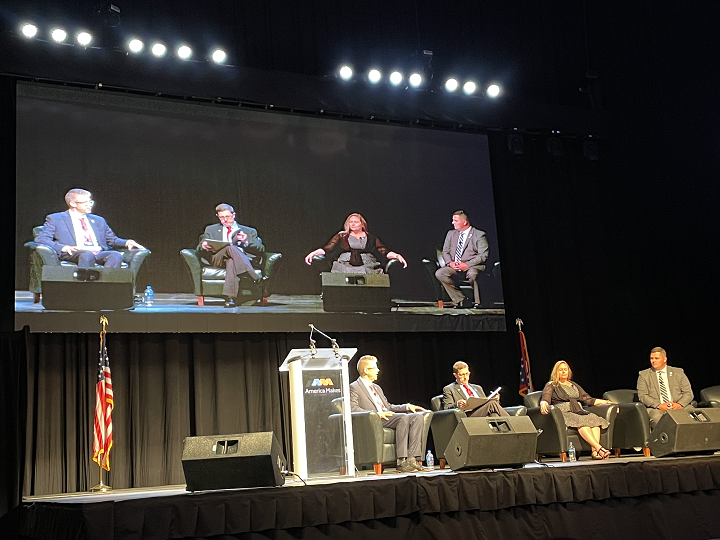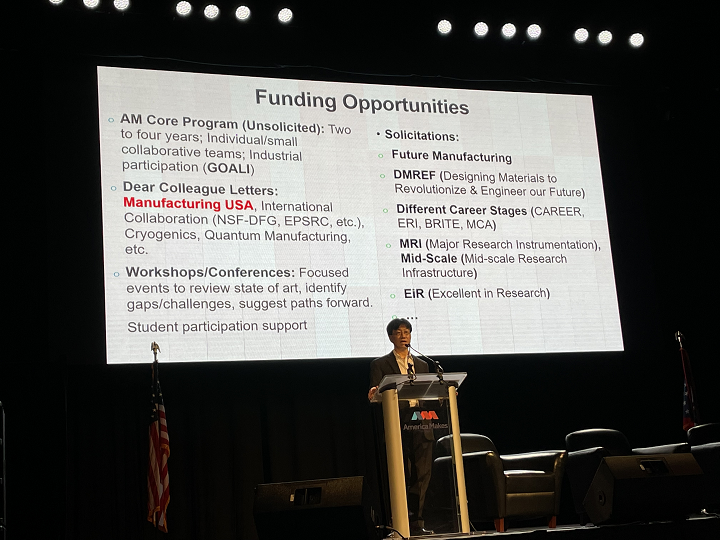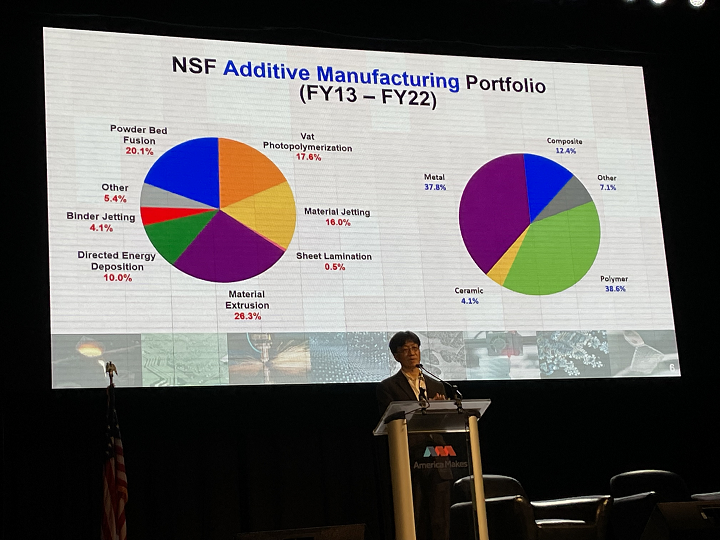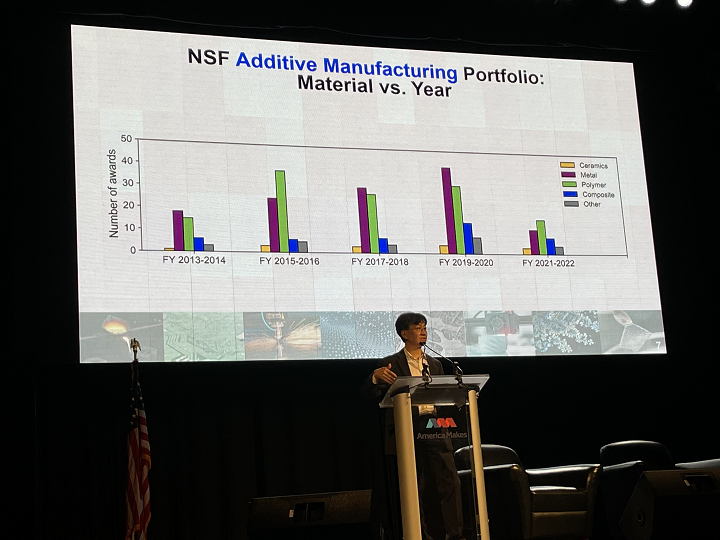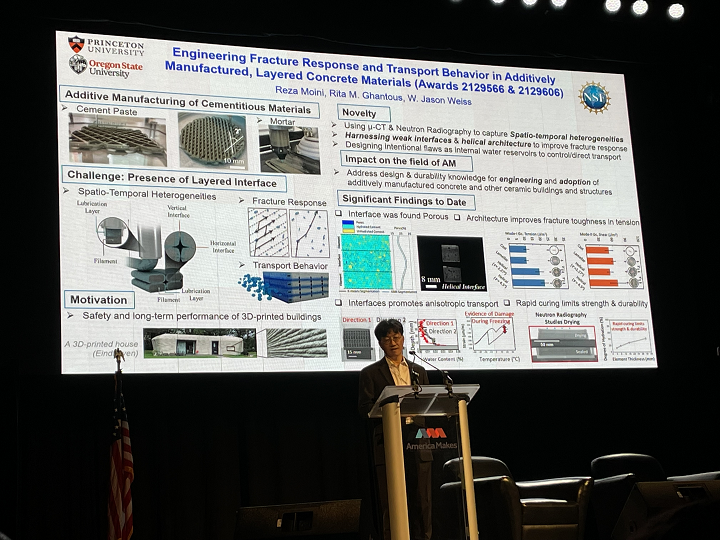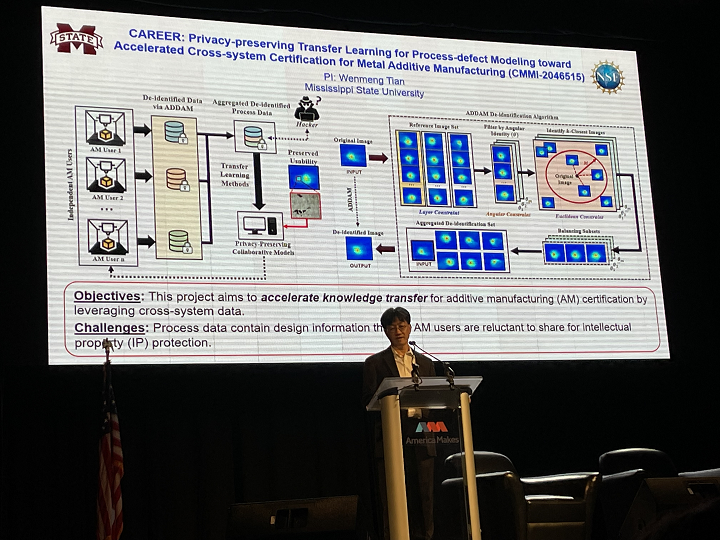America Makes is the United States’ leading public-private partnership for additive manufacturing (AM) technology and education, working to not only accelerate adoption of the technology in the country, but also to increase our manufacturing competitiveness through training, standards publication, projects, and more. The organization, which was the first of the Manufacturing USA Advanced Manufacturing Institutes, opened its doors in Youngstown, Ohio in 2012, and 3DPrint.com was on hand to celebrate its fifth birthday in 2017. So, of course, I made the nearly four-hour drive from my home in Dayton to help celebrate its 10th anniversary at MMX 2022, the Members Meeting and Exchange event for the more than 230 members of America Makes.
In my previous article in this MMX series, I discussed the U.S. Air Force and its take on AM, as relayed in a presentation by Colonel Charles D. Ormsby, the acting director of the Air Force Research Laboratory’s (AFRL) Materials and Manufacturing Directorate. The day continued with a panel that welcomed the directors of America Makes to the stage in an opportunity for the audience to “Ask the Institute Anything!”
Ask America Makes Anything
Moderated by John Wilczynski, the Executive Director of America Makes, the America Makes panelists were Brandon Ribic, PhD, Technology Director; Additive Manufacturing Ecosystem Director Gibson, who moderated an earlier panel; and Josh Cramer, Director of Education and Workforce Development (EWD).
After Wilczynski started with a couple of questions for the individual panelists, he opened the floor up to the rest of the audience, and the first one was for Cramer. The person wanted to know what gaps he sees in EWD, and what he’s not getting from membership to help make a difference. He explained that the institute’s Roadmap looks “more like a matrix, with verticals and horizontals cutting across the page,” and that the team looks for weaknesses, such as live instructor training or accessible outreach with rigor, and tries to address them. Another gap is having availability to on-ramps, as he described the institute’s work as a superhighway, and how to move from awareness to inspiration and beyond.
“How do we bring programs all our members can take to local communities? Some schools have access to programs, but do all? Home schoolers? The exonerated?” Cramer asked. “We’ve looked at hundreds of job roles across the industry and we’re aligning competencies that align with those. Here’s the job, here’s the competencies, here’s the training that can help you get there.”
A man from a materials company asked Ribic how America Makes is able to verify the inputs they receive, and his answer was simple.
“We explicitly trust the expertise of the membership,” he stated. “Members lead the institute, not these four directors onstage.”
He explained that the institute speaks to people from academia, NASA and the FDA, at workshops and events like RAPID, and then advisory board members cross-references the information in order to update the Roadmap.
Supply Chain Disruptions and Regulatory Compliance
Another audience member asked Gibson and Ribic what impediments there are to the supply chain ecosystem, and Gibson said, as she’s heard from several members recently, qualification and transferring it to the supply chain is one of the biggest challenges “we need to get our arms around.” Ribic agreed, continuing on to say that we need to be asking ourselves what should be measured and then making that knowledge available to the community.
“This segues into what I think is a major challenge: making data available to people that allows them to take action at the point of manufacturing,” he said.
He explained that manufacturing requires operational excellence beyond just good practices, though that there’s still a need for skills that foster these practices. Balancing rigor and practicality is necessary to achieve this operational excellence in a way that generates revenue and profit, and knowing what needs to be measured—then doing so in a systematic manner—will build confidence to accepts AM products.
Ribic was also asked how members in other organizations, like aerospace, energy, and medtech, balance managing information and using it effectively to analyze data with regulatory compliance. This is always a big question, and an important topic to keep discussing, as our industry deals with lots of very high-tech sectors which have important standards that must be followed. Ribic said there’s been a lot of great work on this, and that many people know we’re able to measure the important data from AM processes, as well as downstream operations. He then explained that ultimately, “we start big and start to funnel down and figure out how to achieve a model that can tell us something about our products and associated applications,” and that a good fit between the two is necessary in order to “make it appropriate for the operating environment.”
A small business owner told the group that first-time AM users, and everyone else at MMX, was swimming together in “a pool of trust” relating to AM, and wanted to know how to establish more trust outside this pool in order to work better together and confidently seek support from government and other partners. Gibson agreed, stating that America Makes has spent ten years building that trust, these relationships, and confidence in the team.
“In order to take it to the next level, we must extend that trust,” she said. “I’m specifically working in market analysis, which is just one level of that trust.”
She addressed the audience, saying there’s probably many things the small business owners care about, like de-risking and financial issues, that have never been discussed or prioritized, because large businesses don’t have to deal with, but they want to support the small businesses.
“Things like this will build trust and allow us to move forward with funding and create a new reputation for getting things done together,” Gibson concluded. “We have to grow this umbrella.”
Accessing 3D Printing Funds via the NSF
Then, National Science Foundation (NSF) Program Director Kevin Chou took the stage to discuss “Emerging Innovations in Additive Manufacturing Research,” and the foundation’s AM portfolio. He explained that the NSF funds basic research.
Chou explained that manufacturing is a bridge, and that many people come to the NSF requesting funding for advanced manufacturing projects from a program that works to accelerate the advances in manufacturing technologies, with an emphasis on research that alters and transforms manufacturing capabilities, methods, and practices.
The NSF offers multiple funding opportunities and core programs in its budget, with $25 million allocated for its primary program GOALI, which is a proposal looking to stimulate collaboration between academic research institutions and industry. The foundation also offers workshops and conferences, and will issue what it calls Dear Colleague letters, which ask the community to submit proposals.
Solicitations are when a public project call is made, and one of the largest is a cross-agency program called Future Manufacturing, which is focused on biomanufacturing and other technologies. Another type of funding is Designing Materials to Revolutionize & Engineer our Future (DMREF), which is for materials scientists. The NSF also targets work in the early career stages with opportunities like ERI and MCA (Mid-Career Advancement.”
Chou explained that the NSF focuses on advanced manufacturing, not just additive, though many of the projects and research that have been funded include additive technologies, such as bioprinting, metal 3D printing, and topology optimization.
He showed us charts of NSF portfolio projects targeting different AM methods, with material extrusion taking up the largest piece of pie, followed by powder bed fusion and vat photopolymerization. In terms of materials, metal is a high-value application, so it’s the largest piece of its graph, though the foundation is hoping to work with more ceramic projects. Chou said that some of the basic research the NSF is interested in includes processing speed, microstructures, tensile properties, and using X-rays to see the details of the melt pool. The NSF also works with complicated, concentrated alloys, tunable composites, and has one project that’s attempting to insert an enzyme into plastic.
NSF-Funded 3D Printing Innovation
Chou then shared some of the recent AM funding and project awards, including a five-year project from Tennessee Tech focused on gaining fundamental knowledge about residual stress development and pore creation mechanisms in WAAM for molybdenum alloy structures by considering ductile-to-brittle transition temperature.
Other NSF-funded projects he shared focus on a custom bioprinter for regenerative tissue engineering; understanding bond formation, mechanical properties, and microstructural development in cold spray additive manufacturing; and using synchrotron imaging and process modeling to look into the impact that particles have on the molten metal pool in L-DED technology.
In my next and final article in this series, I will describe how the event wrapped up, including the role of public-private partnerships in AM innovation and who America Makes selected to be its ambassadors.
Subscribe to Our Email Newsletter
Stay up-to-date on all the latest news from the 3D printing industry and receive information and offers from third party vendors.
Print Services
Upload your 3D Models and get them printed quickly and efficiently.
You May Also Like
The Market and Industry Potential of Multi-Material 3D and 4D Printing in Additive Electronics
Additive manufacturing leverages computer-based software to create components for products by depositing either dielectric or conductive materials, layer by layer, into different geometric shapes. Since its birth in the 1980s,...
3DPOD 262: Bio-inspired Design for AM with Dhruv Bhate, Arizona State University
Dhruv Bhate is an associate professor at Arizona State University. There, he looks at structures, materials, and design. Previously, he worked at PADT as well as in the semiconductor and...
3DPOD 261: Tooling and Cooling for AM with Jason Murphy, NXC MFG
Jason Murphy´s NXC MFG (Next Chapter Manufacturing) is not a generalist service; instead, the company specializes in making tooling. Using LPBF and binder jet, the company produces some of the...
3DPOD 260: John Hart on VulcanForms, MIT, Desktop Metal and More
John Hart is a Professor at MIT; he´s also the director of the Laboratory for Manufacturing and Productivity as well as the director of the Center for Advanced Production Technologies....


